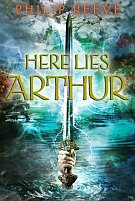|
Medieval
Book Reviews !
All
Things Medieval !
HOME MEDIEVAL
ROMANCE MEDIEVAL
MYSTERY MEDIEVAL
FICTION
MEDIEVAL ECHOES
AUTHORS
|
Here Lies
Arthur

by
Philip Reeve
An Arthurian
story that diminishes women to nothingness.
Publisher: Scholastic Press
(November 2008)
Told
in first person narrative from the lost girl-child discovered by master
story teller and trickster Myrddin, HERE
LIES ARTHUR recounts the familiar Arthurian story from a new,
unusual perspective from the finding of Excalibur to the last days of
the Arthurian kingdom. Gone are the chivalric codes of honor and
behavior. Philip Reeve replaces Camelot with a tale of a rag-tag band
of
men led by a rather barbaric power-hungry leader whose glory is built
upon stories rather actions. Lancelot is stripped away as is the
classic grail quest. HERE LIES ARTHUR
demystifies the Arthurian legends by reducing the elements down to the
"truth," as it reveals the tricks of Merlin alongside the explanation
behind the stories that become legend.
I chose to read this book from a profound love of medieval Arthurian
literature. One aspect I particularly love about Medieval literature
and especially Arthurian literature is the way in which an author
reshapes a story, changing elements to create a new tale. In HERE
LIES ARTHUR, the clever
play on the myths of war and the stories of heroism versus the
realities of war is one of the more intriguing themes explored. The
author makes great points about the art of story telling versus the
truth that speaks to the power of the story as a motivator and the art
of storytelling.
The portrait of Arthur is rather barbaric. All chivalry of the later
romance tradition is stripped away. Mryddin is story-teller, a
trickster (which he is often even in the medieval traditions). Arthur
is a man only concerned with himself and grabbing power and money. He
is a wife beater and he plunders treasures from the church. The church
itself is ridiculed for the greed of the priests, a common theme of
medieval literature itself. HERE
LIES ARTHUR, however, remains mostly on the level of ridicule
whereas medieval literature targets corruption itself more than the
church as a whole. The medieval Arthurian tradition (both the romance
and the chronicle traditions) are themselves reinventions of an earlier
period and some scholars do go back to the pagan roots of elements of
the stories. While the portrayal of the church in HERE LIES ARTHUR does fall in line
with the general tone Philip Reeves creates in Arthur's less than
savory character, there is no counterbalance as there is with some of
the other deconstructions of the Arthurian myth.
Despite my love for the changing shape
of the Arthurian tradition, I found myself deeply disturbed by this
book and the way in which this story was retold. Page after page, for
almost 300 pages, the reader hears over and over and over about girls
versus boys. The girls and women are diminished over and over again
with direct gender statements of how women are nothing, ghostly, their
lives too small for stories. The narrator is a girl who Myrddin
(Merlin) disguises as a boy, who later becomes a girl and the
vice-versa with Peredur who is a boy sheltered by his mother and made
to dress like a girl to keep him safe from war (which to some degree
comes from the Perceval tales). Of course this level of gender play
extends to the male author name speaking through the voice of a girl
who hates being a girl who acts like a boy and is a boy until she
matures. Perhaps the author means to deconstruct the gender paradigms
but HERE LIES ARTHUR does so
at the expense of readers who are pummeled with anti-girl, boys are
cool, and boys will be boys statements. Even though there is a special
moment at the end that reaches beyond these statements, by the time a
reader gets there, s/he has been so saturated by the nothingness of
women that it loses its power. This book might be intriguing for a
medieval feminist scholar to analyze ---- but is this book really meant
for a young adult audience? This modern retelling more misogynist than
any medieval text I have read (quite a few and in the original
languages). Even if the author meant to deconstruct misogyny by this
play of gender, I just cannot imagine a woman or a young adult
girl reading these statements over and over without feeling
diminished. Should boys be encouraged to read this either? Does
diminishing women really make boys stronger and more like men? The
young adult classification of this book seems inappropriate.
Review courtesy
of Amazon Vine
|
Book description
Gwynna is just a
girl who is forced to run when her village is attacked and burns
to the ground. To her horror, she is discovered in the wood. But it is
Myrddin the bard who has found her, a traveler and spinner of tales. He
agrees to protect Gwynna if she will agree to be bound in service to
him. Gwynna is frightened but intrigued-and says yes-for this Myrddin
serves the young, rough, and powerful Arthur. In the course of their
travels, Myrddin transforms Gwynna into the mysterious Lady of the
Lake, a boy warrior, and a spy. It is part of a plot to transform
Arthur from the leader of a ragtag war band into King Arthur, the
greatest hero of all time.
If Gwynna and Myrrdin's trickery is
discovered, what will become of Gwynna? Worse, what will become
of Arthur? Only the endless battling, the mighty belief of men, and the
sheer cunning of one remarkable girl will tell.
|
|

|